#Sultan Murad II.
Explore tagged Tumblr posts
Text
Rewatching the Murad era of Muhtesem Yuzyil: Kosem sure hits different now that I've obsessed about Alicent and Aegon's mother-son relationship a 100 different ways. Unfortunately, my baby Alicent is not the iron-fisted force of nature Kosem is, and Murad shares Aegon's impulsive brashness but his decisions pan out better. The mother-son dynamic though, and the fact that both mothers outlived the sons...plus, judging by the S2 trailer, just like Murad, Aegon is going to make a habit of not heeding the woman who enthroned him.
Sons as their mother's sword arm except the blade is poisoned, URGH!!!!


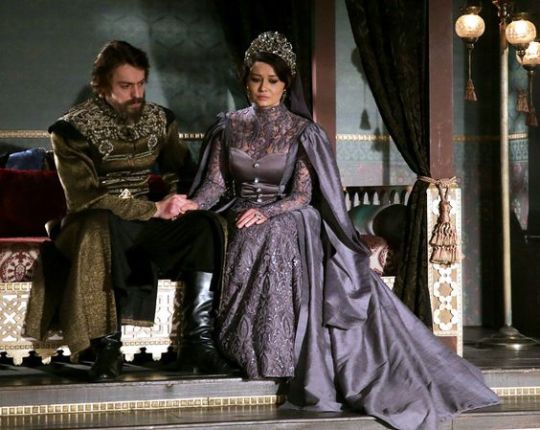

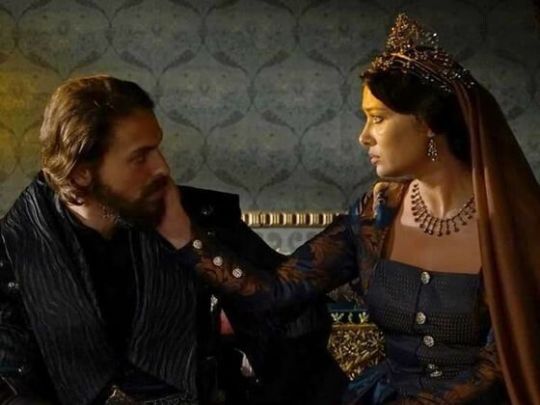
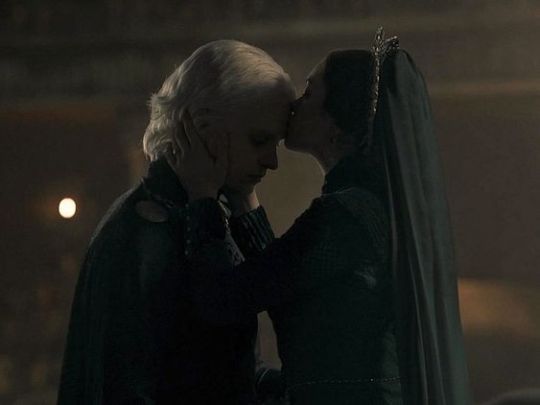


#muhtesem yuzyil#murad iv#kosem sultan#aegon ii targaryen#alicent hightower#muhtesem yuzil kosem#house of the dragon
69 notes
·
View notes
Text








yes i am very normal about my unhinged mother&son duos why you ask
#amarena talks#hotd#house of the dragon#alicent hightower#aegon ii targaryen#magnificent century kosem#magnificent century: kösem#magnificent century: kosem#magnificent century kösem#muhteşem yüzyıl: kösem#muhteşem yüzyıl kösem#kosem sultan#muhtesem yuzil kosem#kösem sultan#murad iv
46 notes
·
View notes
Text
i am struck by the Aegon/Murad parallels
i need to know if Fire and Blood is inspired by Kosem and her kids
alcoholic/dies from poison allegedlyinvolving his mom(show wise, cirrosis irl, going the way Alicentwas writren she will be the one to put him down like her name is Kristi Noem)✔️
no living sons, only one daughter who dies tragically young ✔️
powerful mother who served as regent for a while and successfully put him on the throne✔️
usurped older half sibling who ordered the death of next sibling for the crime of being a contender for the throne(disputed but Rhaenyra is blamed for Helaena's suicide)✔️
orders the deaths of the male heirs despite having no sons (and fails to kill the last one)✔️
killed person he usurped and it was an older relative✔️
dynasty continues through the sibling he tried to kill(in aegon's case succeeded in killing)✔️
daughter had prophetic dreams(Kaya predicted her own death)/Helaena has prophetic dreams(Jaehaera unconfirmed)✔️
married a princess (show wise, Farya is an oc)✔️
killed his brothers(in Aegon's case indirectly because they died fighting for his cause)✔️
6 notes
·
View notes
Text
reallifesultanas Thank you very much for your answer! Yes I meant Dumas not Alderson sorry for that! Is there a reason for the illogical amount of salaries? I mean the earlier salary lists of registers clearly help us to indentify the sultanas. The 1555-1556 registers are 100% logical; the 1603-1604 registers are still logical: Safiye, Handan, aunts of Ahmed, great-aunt of Ahmed, great-great aunt's daughter (Ayse Hümasah), cousin of Mehmed III, far relatives. But then there is this one.. highest salary for the full sisters of the sultan is logical, but then what does the daughters of Murad III doing there? Fahri/Kamer and Hümaşah/Rukiye* are surely Murads and so Ümmügülsüm could be also Murad's... For the lesser salaries Beyhan, Safiye, Hatice I could imagine they were Mehmed III's, maybe Beyhan's Mustafa was Mirahur Mustafa? But these stipends are just not logical... (*Murad III's daughte Rukiye was said to be married to Nakkas Hasan not Huma). And for Ümmügülsüm there is that one report from 1688 (Katherine Trumbull) when it is said she developed a relationship with Sultana Ümmühan, the aunt of the deposed Sultan Mehmed IV, through visits to the harem. This Ümmühan could be Halil Pasha's wife and so Murad III's/Mehmed III's daugher, or is it more likely not an aunt but sister/cousin? Or she truly can be Ahmed I's daughter? There is this 85 numaralı Mühimme defteri that provide some informations suggesting suggesting Ümmügülsüm was sister of Murad IV. Sadly I dont have the book so I cannot check how true is this claim...
I hope you don't mind if we continue here on ottomanladies.
I know the harem register doesn’t seem to make sense from the point of view of hierarchy but we must remember that the hierarchy could be broken on the basis of favouritism. Maybe those aunts were more favoured than the others.

In this table we can see Gevherhan Sultan, a great-aunt of Ahmed I’s, the reigning sultan. Dumas mistakenly identifies her as a daughter of Murad III’s and a concubine of non-haseki rank, but the reality is she’s first because she’s the most senior princess alive. If you look closely at the second category — “Frais de bouche” — she receives the same amount as Ayse and Fatma, Safiye’s daughters. Gevherhan was quite favoured by Ahmed I because she had trained Handan in her household. Also, her late husband Cerrah Mehmed Pasha had performed Ahmed I’s circumcision. Borekçi says that she was the only recipient — apart from Handan and Safiye — of sable fur:
“A register preserved in the Topkapı Palace Archives gives further details of the gifts Gevherhan Sultan received from her great grand-cousin. At the beginning of this register, there are records of the furs and robes of honor sent by the new sultan to his larger family right after his enthronement on December 27, 1603. Here, Gevherhan Sultan is listed as a recipient of a sable robe (semmûr kaplu nimtâne) and recorded as the third female member of the dynasty after the retiring queen mother, Safiye Sultan, and the new queen mother, Handan Sultan, and before all other living sisters and daughters of Murad III and Mehmed III -- a clear indication of her privileged position. Later, on February 6, 1604, she again appears in the register, this time as the only female family member apart from Handan Sultan to receive a fur-trimmed silk robe.”
(I believe the 6 şehzâdegân are unmarried princesses that Ahmed still had to matchmake but this is another story)
I know it’s Rukiye that Öztuna says has married Nakkaş Hasan Pasha but he could be wrong tbh, it wouldn’t be the first time. Also, neither Sakaoğlu or Uluçay confirm this; they give no information about Rukiye except for the identity of her mother. Unfortunately Öztuna never gives his sources so we don’t know where he found that Rukiye was married to Nakkaş Hasan Pasha. I would trust the harem register and contemporary sources (the ragusian diplomat, in this case) more tbh… both say that Nakkaş Hasan Pasha was married to a princess called Hümaşah…
About Beyhan… the problem is the wife of Mirahur Mustafa Pasha went on to marry Cigalazade Sinan Pasha’s son Mahmud Bey in 1612, and died before 1620, the date of Mahmud Bey’s second wedding, which means she shouldn’t have been alive in 1638-39. The Ragusian letter date 1648, though, lists a Beyhan Sultan widow of “Nideli Mustafa Pasha”— unfortunately, I can’t say who this man is or what “nideli” means.
I do agree with you, though. I think that Beyhan, Safiye, and Hatice are daughters of Mehmed III. We know that seven princesses were married in the summer of 1613, after all. A letter dated July 1613 by a Ragusian diplomat, furthermore, says that “at the present there are fifteen sultanas”.
About Katherine Trumbull, I guess you mean this:
“While in Istanbul, Katherine had developed a relationship with Sultana Ümmühan, Mehmed IV’s aunt and sister to Ibrahim II. On 14 July 1688, Katherine met with Ümmühan for the first time, and the two women continued to meet in the imperial harem throughout Trumbull’s residence in Istanbul. During these visits, Katherine must have been accompanied by someone with knowledge of spoken Turkish, or else it is unclear how she would have been able to communicate with the women she met in the harem. At any rate, when she returned to the embassy, she brought to Trumbull news of things taking place in the Ottoman court.” — Ghobrial, John-Paul A, 'Overcoming Distance in Everyday Communication', The Whispers of Cities: Information Flows in Istanbul, London, and Paris in the Age of William Trumbull (Oxford, 2013; online edn, Oxford Academic, 23 Jan. 2014)
Unfortunately, William Trumbull’s diaries were not published, they’re in the British Library. I always like to cross-check my sources and the fact that I can’t read the original kind of annoys me. Ümmühan is quite an unusual name for an Ottoman princess: Ümmi means mother and Han sovereign, it kind of sounds like “valide sultan”, which is why I thought it was a title for a moment but I couldn’t find anything to confirm this. It is kind of interesting, though, that Öztuna says that Ibrahim’s eldest daughter was called Ümmügülsüm, who could have been named after another Ümmügülsüm (the one that in 1622 was unmarried? Who knows)
The Mühimme defteri is not a book but a collection of copies of all the imperial decrees or decisions taken in the imperial council. They’re numbered and the number 85 refers to the years 1630-31. You can find the PDF for free on the website of the Turkish National Archives but, well, it’s in Ottoman Turkish.

(This is one of them)
So I can’t really read it even though I have it.
#ask: ottoman history#reallifesultanas#gevherhan sultan daughter of selim ii#rukiye sultan daughter of murad iii#humasah sultan daughter of murad iii#unnamed daughters of mehmed iii#i'm sorry if the layout looks weird but it's been so long since i used tumblr and i'm a little rusty
13 notes
·
View notes
Text

Murad II. The 6th and perhaps most underrated of the early Ottoman Sultans. He ruled twice, having abdicated his throne in 1444 only to return two years later in 1446. He defended his realm against Crusaders. Reclaimed Thessaloniki in 1430. Annexed Serbia in 1439. Defeated the Crusaders at Varna in 1444. He died in 1451 at the age of 46.
#history#middle eastern history#early modern history#ottoman#turkic#ottoman empire#medieval#medieval history#military history#ottoman sultan#ottoman history#Murad II#Murad
6 notes
·
View notes
Text


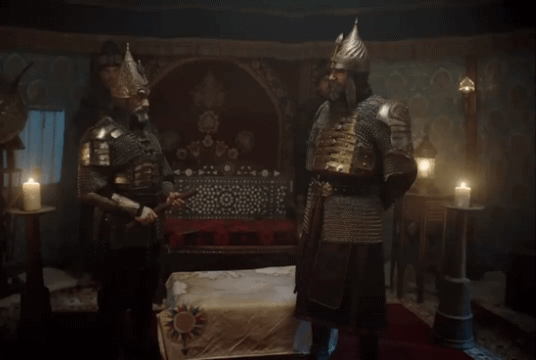






#history#ottoman history#ottoman#ottoman valide#ottoman sultanas#mehmed fetihler sultanı#sultan mehmed ii#mehmed ii gif#mehmed the conqueror#Murad#Sultan murad#sultán#turkish gif#mara hatun#murad#sultans
13 notes
·
View notes
Text






This kaftan was first worn by Huricihan Sultan in the eighth episode of the third season of Magnificent Century. It makes another appearance in the thirty-ninth episode of the same season on Şehzade Cihangir. The kaftan is worn twice in the fourth season, first by Anna Hatun in the thirty-first episode and then by Mihrimah Sultan's son Osman in the final episode.
Magnificent Century: Kösem uses the kaftan twice. It is worn by Şehzade Murad (later Sultan Murad IV) in the twenty-sixth episode of the first season and by Şehzade Süleyman (later Sultan Süleyman II) in the twenty-ninth episode of the second season.
#Muhteşem Yüzyıl#Muhteşem Yüzyıl: Kösem#Magnificent Century#Magnificent Century Kösem#Magnificent Century Kosem#period drama#costume drama#historical drama#Huricihan Sultan#Şehzade Cihangir#Sehzade Cihangir#Anna Hatun#Sultanzade Osman#Sultanzade Osman (Son of Mihrimah)#Şehzade Murad#Sehzade Murad#Şehzade Murad (Son of Kösem)#Murad IV#Süleyman II#Şehzade Süleyman#Sehzade Suleyman#Şehzade Süleyman (Son of Dilaşub)#reused costumes#recycled costumes
13 notes
·
View notes
Text

“I associate King Abdullah II of Jordan with Selim II (Sultan of the Ottoman Empire) and his wife Nurbanu Sultan with Queen Rania of Jordan, I think they are as similar as possible, especially the way they came to power, and I consider Crown Prince Hussein similar to Sultan Murad III (son of Selim II) and Rajwa similar to Safiye Sultan (Nurbanu daughter-in-law and Murad wife).” - Submitted by Anonymous
#King Abdullah II#Queen Rania#crown prince hussein#princess rajwa#murad iii#selim ii#nurbanu sultan#safiye sultan
17 notes
·
View notes
Text
Athener Kaffee-Tagebuch: Leoforos Nikis und Weißer Turm
Jetzt gilt es entlang der Leoforos Nikis am Meer zu flanieren. Der Boulevard beginnt als Fortsetzung der Navarchou Koundouriotou Pavlou an der Platia Eleftherias mit dem Shoa-Denkmal und führt in südöstlicher Richtung entlang der Küste vorbei an der Platia Aristotelous bis zum Weißen Turm, wo er in die Leoforos Megalou Alexandrou übergeht. Sie ist auch als Palea Paralia – Alte Uferpromenade –…
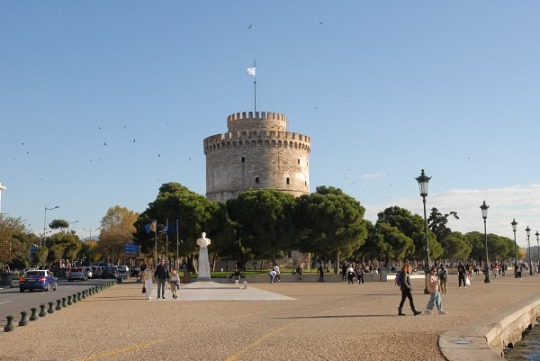
View On WordPress
#Achämeniden#Ägypten#Byzanz#Erzbischof Eustathios#Eustathios von Thessalonike#Konstantin I.#Leoforos Megalou Alexandrou#Leoforos Nikis#Mahmud II.#Palea Paralia#Philipp II.#Platia Aristotelous#Roter Turm#Süleyman der Prächtige#Sultan Murad II.#Thessalien#Thessaloniki#Weißer Turm
0 notes
Photo

The White Tower is a monument and museum on the waterfront of the city of Thessaloniki, capital of the region of Macedonia in northern Greece. The present tower replaced an old Byzantine fortification, known to have been mentioned around the 12th century, that the Ottoman Empire reconstructed to fortify the city's harbour sometime after Sultan Murad II captured Thessaloniki in 1430. The tower became a notorious prison and scene of mass executions during the period of Ottoman rule, earning the name “Red Tower” and “Tower of Blood” (Turkish: Kanlı Kule) . The tower was substantially remodeled and its exterior was whitewashed after Greece gained control of the city in 1912. The White Tower has been adopted as the symbol of the city.
Photo by pastelidis_greece on Instagram.
#greece#europe#history#modern history#modern greek history#white tower#monument#landmarks#thessaloniki#macedonia#greek history#mainland
86 notes
·
View notes
Text
Dracula a Love Story characters and their historical counterparts
Vlad - Vlad III, also known as Vlad the Impaler and Vlad Dracula (Vlad Țepeș), was a 15th-century ruler of Wallachia, notorious for his brutal punishment methods, particularly impaling his enemies. He defended his realm from the Ottoman Empire and became a national hero in Romania.


Mehmed - Mehmed II, also known as Mehmed the Conqueror (Mehmed bin Murad), was the Ottoman Sultan who famously captured Constantinople in 1453. Historically, Mehmed II clashed with Vlad Dracula during campaigns in Wallachia, adding political depth to their enmity.


Radu - Radu III, also known as Radu the Handsome, was the younger brother of Vlad the Impaler and historically served as a ruler of Wallachia under Ottoman control. His rivalry with Vlad is well-documented, as Radu supported the Ottomans while Vlad opposed them.


Sultan Murad - Murad II was a formidable ruler who expanded Ottoman control in the Balkans and fought against various European coalitions. His campaigns laid the groundwork for the later conquests of his son, Mehmed II.


Gjerg Skanderberg - Gjergj (Gjergj Kastrioti), commonly known as Skanderbeg, was an Albanian feudal lord and military commander who led a rebellion against the Ottoman Empire. Skanderbeg's legacy as a defender of Christian Europe against the Ottomans is similar to how Vlad Dracula is viewed by some in Romania. Both are celebrated as national heroes who fought for independence and freedom in their respective lands.


Erzsebet (Erzsi) - Erzsébet Báthory (Countess Elizabeth Báthory de Ecsed), also known as The Blood Countess or Countess Dracula, was a Hungarian noblewoman from the late 16th and early 17th centuries, infamous for allegedly torturing and killing young girls. She is considered one of the most prolific female serial killers in history.


#romance club#rc dracula a love story#rc vlad#rc mehmed#rc radu#rc murad#rc gjerg#rc erzsi#Just a little history lesson
42 notes
·
View notes
Text
Lets talk about Ümmügülsüm Sultan
There is a chance, that Kösem and Ahmed had another daughter together: Ümmügülsüm.
I am so glad, that with Anonymous sender and Ottomanladies, the truth came to light. Ottomanladies answered very long and very detailed about Ümmügülsüm, she shared her thoughts about the topic, now, here, you can find a conclusion from me:
What we know:
A privy purse register from 1622 gives the names of five unmarried princesses, who may be daughters of Ahmed, Osman II, and even Mehmed III: Umm-i Külsum(=Ümmügülsüm), Hanzade, Halime, Fatma, and Akile. Hanzade and Fatma were Kösem's daughters; Akile is possibly mistaken for Atike or Abide; Halime might be Mehmed III's daughter, named after her mother, Halime. But Ümmügülsüm was less clear.
The relazione of Angelo Alessandri from 1637 says that Murad IV had four FULL-sisters. We know three of them: Ayse, Fatma, and Hanzade. But who could be the fourth? Gevherhan was already dead, Atike was well-knownly not a full-sister and also not Abide. Maybe Ümmügülsüm?
There are some decisions and letters of Murad IV, where he mentions Ümmügülsüm as a sister of his. He uses the same wording that he used for Ayse, who undoubtedly was his full-sister, suggesting Ümmügülsüm was also a full-sister of his.
The 1638/39 harem registers mention one Ümmügülsüm Sultan who received the highest payments besides the three already known daughters of Kösem (Ayse, Fatma, Hanzade) and two daughters of Murad III. This means she could be either the daughter of Murad III or Ahmed I. But since Ahmed I's other daughter, Atike - who was not Kösem's - got a lesser stipend, if Ümmügülsüm is Ahmed I's daughter, she had to be Kösem's daughter too and so she is the fourth full-sister of Sultan Murad IV.
In 1648 the Raguzan envoy also mentions her (possibly her as they use the name Iumi), as the wife of Ahmed Pasha, governor of Herzegovina. They probably married ~1642 until the pasha's death in 1648. This was her second marriage, her first husband was one Halil Pasha, with whom she married before 1638.
In book ''Whisper of the cities'' one Ümmühan Sultan is mentioned as she met with the English ambassador's wife. Based on her, Ümmühan was said to be the aunt of deposed Mehmed IV and sister of Ibrahim I. This happened in 1690, so she still was alive then.
There are still questions:
Why no historian ever discovered this information as none of the evidence is new?
Why Ümmi is not mentioned among Ahmed I's children?
Where is she buried? *
When was she born? *
Why Ibrahim did not force her to serve Telli Hümasah (his wife) when he did it to all of the other daughters of Kösem?
To be honest the burial place of Ahmed I is quite a mess. For example there are two sarcofagies for 'Zeynep' daughters of Ahmed I. One of the sarcofagies stands for an adult woman. There was no daughter of Ahmed, called Zeynep who reached adulthood. So maybe the name is mistaken and that Ümmügülsüm. Maybe she was buried somewhere else as she lived a quite long life, survivin everyone around her and her grave is not idetified yet.
Considering the known children of Kösem and their birth date, the most possible for Ümmügülsüm is that she was born during the late reign of Ahmed I. In 1605 Kösem gave birth to Mehmed; in 1606 or 1607 to Ayse; then in 1607 or 1608 to Fatma; in 1609 to Hanzade. While I see that there is a gap here for one more child (if Kösem got pregnant extremely rapidly), she cannot be older than Fatma, as she was also not married off in 1622 yet, and also since we know quite precisely the sequence of these daughters, I do not think another one was born here but no one knows about her. It would be strange. Then in 1612, she gave birth to Murad, but between him and Hanzade there was time for another child - let it be Selim who was born in 1611 or Ümmügülsüm. Then Kasim followed Murad quite quickly, he was born in 1614, and then Ibrahim came in 1615, so there was no time for anyone else between Murad and Ibrahim. After 1615 there is another chance for the birth of Ümmügülsüm. So she either was born after Hanzade (~1611), or after Ibrahim (~1616). Either way - considering she was not just still alive in 1690, but was surely not suffering, dying since she was involved in the diplomacy meeting - she possibly died in the 1690s, she very probably reached 80 maybe even more in the end.

#ottoman history#ottoman empire#valide kösem sultan#mahpeyker kösem sultan#kösem#ahmed i#ümmügülsüm#ümmügülsüm sultan#ümmi#ummuhan#ummugulsum#ümmihan#ummukulsum#ümmükülsüm
27 notes
·
View notes
Note
Sorry to bother you in this account, I would have a question about Ümmügülsüm Sultan, the possible daughter of Ahmed I. The relazione of Angelo Alessandri from 1637, Page 649 says: "Ha il Gran Signore di congionti per sangue quatro sorelle ancora, ma fuori di seraglio, essendo tutte maritate in visiri." And since I am not really speaking italian, I am not sure if "per sangue quatro sorelle" means full-sister or just a way to say sister (and so can mean half sister too). One of my followers - who says he speaks italian - says it means full-sister and confirms that beside Ayse, Fatma and Hanzade there was another full-sister of Murad IV. I mean while I have my doubts, Alderson also lists one Ümmügülsüm (wife of Halil Pasha) based on harem registers, who had the same amount of salary in 1639 as Ayse, Fatma and Hanzade, the daughters of Kösem (and some other women - possible daughters of Murad III had the same amount, while Atike and one Hatice possibly daughters of Ahmed I had less salary). Also, there is the known other register that you also mentioned on ottomanladies page, based on Tezcan: “A privy purse register from 1622 gives the names of five unmarried princesses, who may be daughters of Ahmed, Osman II, and even Mehmed III: Umm-i Külsum, Hanzade, Halime, Fatma, and Akile.” The fact that there was one Ümmügülsüm in 1622 who was still unmarried, and then in 1639 she had the same amount of stipend as Ayse, Fatma, Hanzade and the relazione mentioning that 4 (full)sister thing, maybe suggests that Kösem and Ahmed MAY had another daughter together, Ümmügülsüm? What do you think?
Hello! I guess my askbox on ottomanladies is still closed.
So, your follower is right; what Angelo Alessandri says in his relazione is that Murad IV has four full-blooded sisters who all live outside the palace because they are married. When I read this part, I simply assumed that the fourth princess was Gevherhan but we don’t have any information about her after Recep Pasha’s death in 1632. Then, I assumed he was wrong because it wouldn’t be the first time a European ambassador mistook half-siblings for full-blooded siblings.
About Ümmügülsüm, I have always assumed he was a daughter of Mehmed III’s or Murad III’s. I have never paid attention to her, as I’m sure you know from my posts on ottomanladies.
But you made me curious so I spent some time looking into this.
First, I think you meant Dumas when you mentioned that list based on harem registers because I have found it in Les Perles de Nacre du Sultanate. Alderson doesn’t list an Ümmügülsüm Sultan among Ahmed I’s daughters (unless I somehow missed it).

Secondly, I think there is a problem with this source: on page 62, the register is from February 1649 to February 1650. In Annex A, though, (page 461), she says that the same register is dated February 1639. So what is the truth? February 1639, because the register keeps saying “Şevval 1048”, and that’s February-March 1639 (you can google it). The mistake on page 62 is… weird, though.
Moreover, the list above is somewhat different from the transliteration she put in Annexe A. For example, on page 463 she says that the register says “Hümaşah Sultan merhum Nakkaş Hasan Pasha”, but on the list she put on page 62, the same Hümaşah Sultan is married to one Hüseyin Pasha. I don’t understand why she changed the source without addressing it— or is it just a typing mistake? I hope it is because I think Hümaşah Sultan was truly married to Nakkaş Hasan Pasha: Nakkaş Hasan Pasha was identified as married to one of Ahmed I’s aunts by the Baron de Selignac, and a letter dated 6 October 1642 by a Ragusian diplomat lists among Ibrahim’s aunts one “Humascie sultana moglie di Hasan Pascia [Hümaşah sultan wife of Hasan Pasha]”. In another letter, this one dated 7 July 1648, Hümaşah is identified as “moglie di Nachasc Hasanpascia Humasce sultan vedova [Hümaşah sultan, widow of Nakkaş Hasan Pasha]”.
If Dumas voluntarily changed Hasan Pasha into Hüseyin Pasha then I don’t know why she did it because contemporary evidence suggests that this princess called Hümaşah was Ahmed I’s aunt and therefore Ibrahim’s great-aunt (I won’t fault the Ragusian diplomat for not stating the difference because it wasn’t done often at the time), and was married to Nakkaş Hasan Pasha, who is called “merhum” in the harem register because he was deceased at the time.
Similarly, on page 462, it is listed one “Kameri Sultan merhum Sofi Bayram Pasha”, but on the list on page 62, she is called Fahri. Again, what prompted Dumas to change the wife’s name? Is it because Öztuna says that Fahri/Fahriye Sultan (daughter of Murad III) was married to Sofu Bayram Pasha? Then again, why was she called Kameri in the register? Is it a mistake from the clerk or did she have multiple names? Or did Dumas transliterate her name wrong? Or did she change the princess’ name into Fahri because that’s what Öztuna says? Interestingly, in the family trees in Annex B, she’s called Fahri again. The same Ragusian diplomat above also lists the wife of Bayram Pasha: “Vanni sultana moglie di Soffi Bariam Pascia”; unfortunately I cannot say what Vanni should be because it doesn’t sound like Kameri at all. It could sound like Fahri but… it’s a stretch.
Beyhan Sultan, Safiye Sultan, and Mihrimah Sultan are widows too but it’s difficult to identify them because their husbands are one “Mustafa Pasha”, one “Mehmed Pasha”, and a “Mehmed Pasha from Kefe”. I tried to google this Mehmed Pasha from Kefe and everyone says he was married to Mihrimah Sultan, daughter of Murad III. The problem is the sources of this claim (on those websites) do not say this. The Ragusian letter talks about a Beyhan Sultan married to a “Mustai Pascia” which could be Mustafa Pasha, but this is all I have to say.
I also would like to highlight that the princesses listed in the Ragusian letter are those who received gifts from the Ragusian diplomat so there could have been more, especially aunts.
As for “Atike Sultan Kenan Pasha” (who receives 9,900 aspers per month): she seems to be Ahmed I’s daughter Atike (also confirmed by the Ragusian letter, who lists her among Ibrahim's sister).
Now, about “Ümmügülsüm Sultan Halil Pasha” (who receives 12,900 aspers per month): I still personally maintain that she was an aunt and not a sister. I could not identify her, nor her husband Halil Pasha, but we have to keep in mind that we don’t have all the names of Mehmed III’s daughters. In the Ragusian letter dated 1648, there’s one “moglie di Hersechli Ahmet Pascia Iumi sultan [wife of Hersekli (? it could mean that he comes from Herzegovina) Ahmed Pasha, Iumi Sultan” (Iumi kind of sounds like Ümmi). It’s basically ten years later Dumas' list so she could have changed husband in the meantime but unfortunately, I couldn’t identify “Hersechli Ahmet Pascia”— if someone else has information about him, please do not hesitate to share (with sources, please).
I’m sorry this was so long and unhelpful, I was carried away :(((
EDIT: I have found the Ragusian letters in V. Miović - Per favore della Soltana: Powerful Ottoman Women and Ragusan Diplomats
34 notes
·
View notes
Photo

Mehmed II
Mehmed II (1432-1481 CE), also known as Mehmed the Conqueror, was the seventh and among the greatest sultans of the Ottoman Empire. His conquests consolidated Ottoman rule in Anatolia and the Balkans, and he most famously triumphed in conquering the prized city of Constantinople, transforming it into the administrative center, cultural hub, and capital of his growing empire. His victories would mark the end of the Byzantine Empire and usher a new era of Ottoman dominance in the Eastern Mediterranean.
Early Life & Family Origins
Born on 30 March 1432 CE, Mehmed was the third son of Sultan Murad II (r. 1421-1451 CE), and Hüma Hatun, a concubine of Balkan origins from Murad's harem. His paternal grandfather was Mehmed I (r. 1413-1421 CE) and traced his ancestry back to Osman I (r. 1280-1323 CE), the founder of the Ottoman Dynasty. Mehmed's name was derived from the name of the Islamic Prophet Muhammad (570-632 CE), and unlike the naming customs of other Islamic cultures, in Turkish tradition, the name Muhammad was generally reserved for the Prophet himself.
Mehmed spent his early childhood in Edirne, until he was moved to the Black Sea city of Amasya and replaced his brother Ahmed as the governor of the province in 1437 CE after his death, despite being five years old. Mehmed's status as a child of the sultan afforded him the opportunity to study under the best scholars of the region. He had many tutors throughout the years, teaching him theology, history, foreign languages, among many other topics. These personal tutors reserved specifically for Ottoman royalty were referred to as lalas and played an essential role in preparing Ottoman royals for the intricacies of administration. Mehmed's readings of various Islamic writings would have a significant impact on his ambitions as a sultan. His desire to conquer Constantinople was inspired by the writings of Arab writers Al-Kindi, Ibn Khaldun, and further cultivated by a hadith (or saying) attributed to the Prophet Muhammad, who prophesized a Muslim army would conquer the city.
Continue reading...
39 notes
·
View notes
Text



---

✨Renaldo✨

#i contribute#---#i am amazed you survived that lilbluebastard#and impressive feat indeed#i'll send you your achievements over message✨#it is so weird having Anderson live in my brain#like... anderson opinions#on EVERYTHING#and i might not be atheist#but i am agnostic#and the catholic fanatic FREAKS ME OUT-#but yes#the... “event”#happens in the court of sultan Murad II#historic accuracy wise at least#I also need to note#in bold and underlined 10-fold#ISLAM FAITH IS OKAY#there are terrible people within every faith#and there are good amazing people within every faith#we should never judge a person by their faith#but by their individuality and actions.#just... need to state that#especially with everything going on in the news
59 notes
·
View notes
Note
DAUGHTERS OF AHMED I AND MURAD IV
Ahmed I had six daughters who reached adulthood: Gevherhan, Ayşe, Fatma, Hanzade, Atike and Ümmügülsüm.
Gevherhan Sultan was Ahmed I’s eldest daughter; married twice to Ökuz Mehmed Pasha and Topal Recep Pasha. She died before 1631. I believe that Ragusian report of 1642 mentioning Ibrahim’s sister as sultana moglie di Mustafa Pascia detta Guiheri was mistaken for Hanzade(?). Again, in Osmanli devltinde kim kimdi it is clearly stated that Hanzade married Mustafa Pasha in 1643. So, it stays as a questionmark...
Atike Sultan was Ahmed I’s daughter born in late 1600s. She was married at the beginning of the reign of Murad IV to Koca Kenan Pasha, and eventually in 1652 to Doğancı Yusuf Pasha (Turhan personaly take care of chosing husband for her). I have just problem detecting year of her death; source claim 1672/74 (but I would say it was when Turhan’s daughter Atike died). One source Atatürk konferansları suggest her death date as 1660. Anyway, it seems that historians were unable to bifurcate daughter of Ahmed I and Ibrahim I, and they mixed them with each other at times…
Ayşe Sultan’s marriages are well dated and known. Exept two things: she married Hafiz Ahmed Pasha in 1622 (which I will prove in discussion below) and we don’t know who was her husband in early 1650s. Her last husband was Mustafa Pasha. She died in 1656.
Ümmügülsüm Sultan was born either in 1610 or 1617. Her only known husband during reign of Murad IV was some Halil Pasha. I maybe have found something about him by Süreyya Mehmed Bey:
Halil Paşa - Enderun'dan yetişip mîrahûr-ı evvel olmuştu. 1048 'de (1638/ 39) veziriik verilerek Bağdadim fetih müjdesini İstanbura getirmiştir. Ardından saltanat değişikliği dolayısıyla gözden düşmüş olarak veffat etmiştir.
She was remarried in 1641 to governor of Herzegovina Ahmed Pasha. This marriage was also recognised by Kamil von Behr, and he referred to her as Patti Sultana. She was presented gifts as his wife in 1642, 1648 and 1655. Even she didn’t continue to receive Ragusian gifts, she was still alive during reign of Süleyman II, being alive in 1688, when she started to receive visits of Katherine Trumbull, wife of an English ambassador. On such visits, Katherine was able to collect news from the Ottoman court, such as the rumour in July 1690, later disproved, that Sultan Mehmed had died.
FATMA SULTAN
I would strongly suggest that not all marriages of Ahmed I’s daughter Fatma Sultan are oficially known. Evliya Çelebi mentioned that Fatma had twelve husbands before Melek Ahmed Pasha. I think that I am only person in this world that would claim now that his claims wasn’t sarcastic and that he was telling truth. Now, ambassador’s report from 1st April of 1622 claimed that Sultan Osman succeeded to marry his half-sisters Ayşe Sultan and her younger sister, and that he plans to marry third sister soon (Gevherhan was already married to Recep Pasha):
Continua tuttavia la Maestà sua gia molti giorni nel detto serraglio, dove ha dissegnato maritar in diversi, soggetti 200 di quelle donne che vi habitano, havendo anche concluso matrimonio di due sue sorelle; una fu moglie di Nasuf, in Cafis Bassa di Van, che hora si trova in viaggio di ritorno, et fu gia capitan del Mare, et l’altra minor nel suo Tornacchi, che è un capo de Giannizzeri, di quelle, che hano cura delle Grue di sua maesta, et di quella caccia un'altra ne voleva dar al figliolo, che fu Cemecogli, ma egli sin hora si scusa con la povertà, riuscendo il matrimonio con le Sultane ne per la molto spesa, et per il loco predominio sopra i mariti, peso granissimo, et intollerabile dai Bassa di conto mai procurato. é stata la maestà sua questa settimana piu d’una volta incognita nell’Arsanele, per veder se si sollecita il lavoro, et ha donato al Capitan Bassa doi Veste a tal effetto, il quale affretta hora grandemente quello delle galee per mar negro, che saranno venti fra pochi giorni all’ordine per partir.
In work An Examination of Daily Politics and Factionalism at the Ottoman Imperial Court in Relation to the Regicide of Osman II (r.1618-22) (p. 66) author, using the same report, succeed to identify husbands of these Sultanas:
In late March 1622, the sultan married Ayşe Sultan, the ex-wife of former Grand Vizier Nasuh Pasha, to the Governor of Van, Hafız Ahmed Pasha, and his other sister, to the Governor of Damascus, Murtaza Pasha.
This is great, because the Sultana who was married to this Murtaza Pasha was (as Venetian report says) younger than Ayşe, and I would certainly say that this was Fatma’s first husband. The third one who was planned to be given in marriage to Murtaza Pasha’s son was most probably Hanzade. To remind you, Gevherhan was married for Recep Pasha at the time.
P.S. Who was daughter of Kosem Sultan refferend in letter she prepared for pasha in 1626 after she sent her daughter Fatma? She was never named. Historians made wrong assumption that it was Ayşe Sultan, because Hafiz Ahmed Pasha was Grand Vizier at the time, and they lacked information when did she married him, and with their free will chose is was Ayşe. I would made an assumption that she was most probably Ümmügülsüm. But still, we don’t know who this Pasha was…
At the beginning of reign of Murad IV, one of his sisters married Şehid Ali Pasha (d. 1624) (see Sakaoglu). This also was most probably Fatma, as her sisters Ayşe, Hanzade and Gevherhan had established husbands (Hafiz Ahmed Pasha, Bayram Agha and Topal Recep Pasha). According to Hammer, Atike was married before 1627 to Kenan Pasha who was seventh vizier in Divan. And please don’t ask me in which work, but I also found that Evliya stated that Grand Vizier Kemankeş Kara Ali Pasha married sister of Murad IV. I remember I was shocked, but I hope I will find again that same statement. Anyway, there is one more thing said in Demetrius Cantemir’s book The History of the Growth and Decay of the Ottoman Empire about one of Murad IV’s sister which occupied my mind, and made me think that it was about Fatma, because of her well-known greedy character:
Murad IV’s sister had four husbands in one year, and not the one of the marriages was celebrated according to the custom. They were accused of some crime, and put to death by the emperor, and their riches with all their effects assigned indeed to the Sultana as their law-wife…
Her (first officialy known) new husband was Çatalcalı Hasan Pasha, whom she married in 1624. She forcefully divorced him, as Murad IV’s was disturbed by Kösem’s extensive support for Hasan Pasha. Anyway, he continued his duties and even became Kapudan Pasha until he was poisoned by Recep Pasha in 1631, or rumour does say so (source: İstanbul armağanı, p. 117). After divorce, she was married in the same year to governor of Egypt Kara Mustafa Pasha, who was executed by Murad IV because of some action contrary to the law of God.
In work Fatma Sultan: A Sultana in the Shadow of Passion and Wealth on page 255, author cites source which claims she was married in 1629 to Sarraç Mustafa Pasha. Possibly.
I would now stress out that Fatma married Canpoladzade Mustafa Pasha in 1632. But between him and Sarraç Mustafa Pasha, she definitely had one more marriage. I will give you Venetian source I found in Vesna Miović’s work (p. 188, n. 258):
26.10.1631. Il Capitan del Mare si speta qua col primo bon tempo…al quale si tiene per certo che e stata promessa la sultana vedova del Pascia morto a Scopie questa estate…
As you see, Fatma was promissed to Kapudan Pasha (you fill find out Canpoladzade Mustafa Pasha was Kapudan Pasha from October 1630 until July 1632 if you check the right sources) in October of 1631, before she married him in 1632. But the most interesting thing is that, when she was promised to him, she was widow of governor of Skopje who died at summer of 1631. This guy’s identity was Kaçanikli Mehmed Pasha, who was really governor of Skopje and died in 1631.
As you all know, Canpoladzade Mustafa Pasha was executed in 1636. With him, she had sons Hüseyin and Süleyman. After his death, in 1637, she remarried Koça Yusuf Pasha (in 1638 records mentioned as his wife) and stayed with him in marriage until his death in 1658. They even had son, Ömer.
Her last three marriages were with Melek Ahmed Pasha, Kanbur Mustafa Pasha and Közbekçi Yusuf Pasha. But I would suggest she had at least a marriage between Yusuf Pasha’s death in 1658 and marriage with Ahmed Pasha in 1662.
According to work Fatma Sultan: A Sultana in the Shadow of Passion and Wealth, on page 256, we find out that Fatma Sultan died in 1671, most possibly during March:
Fatma Sultan 1671 yılında yaklaşık 66 yaşında vefat etti. Kaynaklarda Fatma Sultan’ın ölüm tarihiyle ilgili net bir bilgiye yer verilmemiş, genellikle Kozbekçi Yusuf Paşa ile evliliğinden sonra öldüğü ifade edilmiştir. Ölüm sebebi belli değildir. Terekesinde satılacak mücevherlerin kaydedildiği tarih 14 Zilkade 1081/25 Mart 1671 olarak gösterilmiştir (TSMA.d. 10457/124). Fatma Sultan’ın tasarrufunda bulunan Manastır kazası paşmaklık hassı 1671 yılının Mart ayından itibaren Haseki Sultan’a verilmiştir (MŞS. 21: 72, 75). Bu bilgilere göre Fatma Sultan’ın 1671 yılı başlarında vefat ettiği anlaşılmaktadır. Cenaze ve defin işlemlerinden sonra mirasın kayda geçirildiği düşünüldüğünde, terekenin toplanmasının zaman aldığı görülmektedir. Kabri, babası Sultan I. Ahmed’in türbesindedir (Mehmed Süreyya, 1996, s. 14)
Beside Ahmed I’s daughters, there were several unknown marriages of daughters of Murad IV. In Angelo Alessandri’s report from 1637, he says Murad IV had eleven-year-old daughter he intends to marry to Silahdar Mustafa Pasha. Additionally, it is known that thirteen-year-old daughter of Murad IV was married to Tüccarzade Mustafa Pasha in 1640 (Sakaoglu, Alderson). Now, what if I tell you that Silahdar Mustafa Pasha and Tüccarzade Mustafa Pasha were the same person? See this: https://www.suvakfi.org.tr/cesme/adalar/kaptan-i-derya-tuccarzade-silahdar-musahip-mustafa-pasa-cesmesi-h-1048-m-1638
Tüccarzade Silahdar Mustafa Pasha was executed in 1642 (not 1641 as Sakaoglu claims) as governor of Timisoara. Also, work Life After the Harem: Female Palace Slaves, Patronage and the Imperial Ottoman Court , p. 83, says:
According to Naima, in 1642, the sword bearer, husband of Kaya Sultan (daughter of Murad IV) was murdered.
All in all, I want to point to fact that Kaya Sultan was the eldest daughter of Murad IV, born in 1627, who married Mustafa Pasha in 1640 until his execution. She remarried in 1644 to Melek Ahmed Pasha. I am conversant with statements of her being born in 1633, which I strongly evaluate as UNRELIABLE.
Only Öztuna claimed of Murad IV’s daughters, Hanzade Sultan and Gevherhan Sultan, married in August 1645. Hanzade married Nakkaş Mustafa Pasha (d. 1657; different from same-named husband of Hanzade’s same-named aunt, but this Nakkaş Mustafa Pasha died in 1653 – again, I am SUSPICIOUS about this), and Gevherhan Sultan, who married Haseki Mehmed Pasha (who actually married to Turhan’s daughter Ayşe Sultan in 1653). As Haseki Mehmed Pasha remarried in 1553 to daughter of Ibrahim, Gevherhan died before (even before 1648, as she didn’t receive gifts from Ragusians). Hanzade existed, she was still alive in 1662, and was at the time married to some vizier Musa Pasha.
Mahmiye-i İstanbul’da Ali Paşa-yı Atîk mahallesinde sâkin Dergâh-ı âlî dâme mahfûfen bi’l-meâli kapıcıbaşılarından iftihârü’l-emâcid ve’l-ekârim câmi‘ü’l-mehâmid ve’l-mekârim Mîr Mehmed Ağa b. Melek Mehmed meclis-i şer‘-i hatîrde işbu bâ‘isetü’l-kitâb zevcesi Bedirhan bt. Nimetullah tarafından ikrâr-ı âti’l-beyânı tasdîka vekîl olup nehc-i şer‘î üzere vekâleti sâbite olan fahrü’l-akrân dayısı oğlu Ebulkâzım Bey b. Yusuf mahzarında ikrâr ve takrîr-i kelâm edip mahmiye-i mezbûrede hısn ebvâbından Yenikapı hâricinde merhûm eş-Şeyh Merkez Efendi mahallesinde vâki‘ silk-i mülkümde münselik olup bir tarafdan vezîr-i zî-şân düstûr-ı âsaf-nişân Musa Paşa hazretleri mülkü ve bir tarafdan Sultanü’l-muhadderât bürhânü’l-muvakkarât Hanzâde Sultan -dâmet ismetuhâ- hazretleri mülkü ve bir tarafdan Hayrunnisa Hatun bt. Mehmed Efendi mülkü ve bir tarafdan tarîk-i âm ile mahdûd olup hâriciyesi iki bâb tahtânî odayı ve bir ahırı ve su kuyusunu ve mahzeni ve bir dolabı ve hadîkayı ve kenîfi ve dâhil iyyesi bir bâb fevkānî odayı ve bir hücreyi ve bir havuzu ve iki sofayı ve bir kasr-ı yed ve bir matbahı ve üç su kuyusunu müştemil olan menzilimi bi-cümleti’t-tevâbi‘ ve’l-levâhık müvekkile-i mezbûre Bedirhan Hatun’a beş kîse riyâlî guruşa tarafeynden îcâb ve kabûlü hâvî bey‘-ı bâtt-ı sahîh-i şer‘î ile bey‘ ve teslîm edip ol dahi minvâl-i muharrer üzere iştirâ ve kabûl ve tesellüm eyledikde semeni olan meblağ-ı mezbûr beş kîse riyâlî guruşu müvekkile-i mezbûreye cihet-i karz-ı şer‘îden on iki kîse riyâlî guruş deynim olup zimmetimde bâkī altı kîse riyâlî guruşun beş kîsesine takās edip ol dahi mukāssa ve kabûl eyledikden sonra ba‘de’l-yevm hudûd-ı mezbûr ile mahdûde olan menzil müşârün-ileyhâ Bedirhan Hatun’un mülk-i müşterâsıdır keyfe mâ teşâ’ ve tahtâr mutasarrıfe olsun dedikde gıbbe’t-tasdîkı’ş-şer‘î mâ-vaka‘a bi’t-taleb ketb olundu.
Anyway, Hanzade Sultan (daughter of Ahmed I or eventually Murad IV) really had a son with Nakkaş Mustafa Pasha. From judicial report in 1685:
Mahmiye-i İstanbul’da Ayasofya kurbunda Taşodalarda sâkin ekmekçi el-Hâc Ali b. Şaban meclis-i şer‘-i hatîr-i lâzımü’t-tevkīrde mahmiye-i mezbûrda Demirkapı kurbunda Çelebioğlu mahallesinde sâkin umdetü’l-a‘yân ve’l-eşbâh Nakkāş Paşazâde Abdülbâkī Bey mahzarında ikrâr ve takrîr-i kelâm edip târih-i kitâbdan yirmi sene mukaddem mûmâ-ileyhin vâlide[si] merhûme Hanzâde Sultan’ın baş ağası ve abd-i mu‘takı olan İdris Ağa b. Abdullah’a beynimizde ma‘lûmetü’l-evsâf Gürciyyetü’l-asl bir re’s câriyemi yüz otuz guruşa bey‘ ve teslîm ol dahi iştirâ ve tesellüm ve kable’l-edâ ben hacc-ı şerîfe deryâdan giderken harbî kefere beni ahz ve on dört sene mikdârı esir edip ve ben dârü’l-harbde iken merkūm İdris Ağa fevt olup verâseti usûbet-i nesebiyye cihetinden mûmâ-ileyh Abdülbâkī Bey’e münhasıra olmağla mûmâ-ileyh Abdülbâkī Bey terekesine vaz‘ ve kabz eylemeğin hâlâ ben semen-i mezbûr yüz otuz guruşu müteveffâ-yı merkūm İdris Ağa’nın terekesine ber vech-i muharrer vâzı‘ü’l-yed olan mûmâ-ileyh Abdülbâkī Bey’den taleb ve da‘vâ eylediğimde ol dahi cevâbında mûrisim mezbûr İdris Ağa senden ber vech-i mübeyyen iştirâ ve kabz eylediği ma‘lûmum değildir deyû inkâr ve beynimizde münâza‘ât-ı kesîre [84b] vâkı‘a olmuşidi el hâletü hâzihî muslihûn tavassut edip mûmâ-ileyh Abdülbâkī Bey benimle beş guruş üzerine sulh oldukda ben dahi sulh-i mezbûru kabûl ve bedel-i sulh olan meblağ-ı mezbûr beş guruşu yedinden ahz u kabz ettiğimden sonra husûs-ı mezbûra ve gayra müte‘allika âmme-i da‘vâdan mûmâ-ileyh Abdülbâkī Bey’in zimmetini ibrâ-i âmla ibrâ ve iskāt eyledim min ba‘d da‘vâ ve nizâ‘ım yoktur dedikde gıbbe’t-tasdîki’l-vicâhî mâ hüve’l-vâki‘ bi’t-taleb ketb olundu. Fi’l-yevmi’r-râbi‘ aşer min Şa‘bâni’l-mu‘azzam li sene seb‘a ve tis‘în ve elf.
Next very interesting daughter of Murad IV was Rûkiye Sultan. She was born in early 1630s, as she married around 1640s to Küçük Musa Pasha. Musa Pasha was mistaken to be husband of daughter of Ahmed I, Abide Sultan – who didn’t exist. Abide Sultan was daughter of Murad III and wife of Muslu Agha, and Rûkiye was Küçük Musa Pasha’s wife. She received gifts in 1648 as his widow. Rûkiye Sultan was mentioned by Ragusians in 1655 (source: Acta et Diplomata Ragusina) as Ruchie sultana, moglie di Telak Mustafa passa. Also, in 1662, she received gifts as Rukie Sultana moglie di Zelak Mustai Passa, the same guy. I succeeded to figure out his identity, he was Dellak Mustafa Pasha. And very interestingly, Dellak Mustafa Pasha was executed in 1662 by orders of Mehmed IV. It seems that it is right information that Rûkiye Sultan was remarried in 1663 (Sakaoglu) to Seytan Ibrahim Pasha. And he was also executed in 1685, while being governor of Buda. I would note that it is incorrect she married Gürcü Mehmed Pasha, he was husband of Murad IV’s granddaughter, daughter of Safiye Sultan, Rûkiye Sultan (d. early 1697). She died in March 1696 (Sakaoglu) or 1716 (Alderson). What problem did Mehmed IV had with Rûkiye Sultan, so he executed both her husbands?
Safiye Sultan married at least two times: in 1649 she married firstly Haydarzade Mehmed Pasha. She was recorded in 1655 gifts as Safie sultana moglie di Haidar Sade, figlia di sultan Mourad, and as his widow in 1662. It was false information that he married Ibrahim’s daughter Kaya, she never existed. Anyway, her next known marriage was in probably 1663 to Sari Hasan Pasha, during which she died. But according to Ragusian envoys, he was referred in 1670 as Hussain passa. She died before 1676.
Murad IV also had a daughter named Hafsa Sultan. Only thing known about her is that she married some Hüseyin Pasha (source: İslâm ansiklopedisi: İslâm âlemi tarih, coğrafya, etnoğrafya ve biyografya lûgati – cilt 8; page 646). Actually, if you see Türkischer Biographischer Index (page 489), you will see there were eight Hüseyin Pashas who were governors during reign of Mehmed IV (different than Deli Hüseyin Pasha).
There is possibility that Murad IV had a daughter named Ayşe Sultan, but I am reasonably sceptical about it. I will explain it later, when I make a discussion of daughters of Ibrahim and Mehmed IV, which is the hardest task. I don’t know when I will make that one because my academic year starts in ten days, and I need more time to research and observe the Sultanas from the second half of the seventeenth century. Anyway…I really tried hard to find some unrecorded marriages of these analysed Sultanas, I’m glad that I have determined at least one-two marriages of Ahmed I’s daughter Fatma we didn’t know, and also with daughters of Murad IV.
This is also a topic I’m very interested in.
I’m going to sum up everything so it’s easier to read. I am very sorry but it’s long.
Gevherhan Sultan binti Ahmed I
she was Ahmed I’s eldest daughter (child?), named in honour of his great-aunt Gevherhan Sultan binti Selim II, who was still alive at the time of the princess’ birth. She firstly married Öküz Kara Mustafa Pasha in 1611-1612 (when the pasha came back from Egypt). Mustafa Pasha died in 1620. She secondly married Topal Recep Pasha during Osman II’s reign, with whom had a daughter, Safiye Hanımsultan, probably born in 1630. Gevherhan died before July 1631 (Muharram 1040), when an imperial decision calls her “deceased”. The Ragusian diplomats were wrong when they listed “Guiheri” among Ibrahim’s sisters in 1642. Gevherhan had already died by then. This is confirmed by a harem register dated February 1638-39 in which her daughter Safiye is listed but not her. (I should probably make a gifset about this but I deleted all my gifmaking stuff DDDD:)
Atike Sultan binti Ahmed I
as of now, we don’t have solid evidence on her date of birth, except for Öztuna who says she was born around 1614 (but he also says she’s Kasım’s twin…). Interestingly, Tezcan in Searching for Osman says that she was married to “the son of Ekmekçizade Ahmed Pasha (d. 1618), most probably in 1618”. Unfortunately, I don’t know who that is because I couldn’t find his name. Anyway, in the early years of Murad IV’s reign, Atike married Kenan Pasha, as Giustiniani in 1627 says that “Chinan” was married to the sultan’s sister:
Per ultimi sedevan nel Divano doi altri cognati del re, l’uno Chinan, l’altro Mustaffà, ambidoi poco prima del mio partir spediti quello in Grecia et questo in Natolia sotto titolo de inquisitori con suprema auttorità contra le violentie et tirannidi che si commettevano in quelle provintie, ma in effetto per cavar da esse grosse somme de denari per le guerre contra il Persiano.
Koca Sofu Kenan Pasha died in 1652 and in the same year, according to Uluçay, she married Doğancı Yusuf Pasha.
About her death, Uluçay says nothing. Sakaoğlu, on the other hand, says she died before 1670, that is when Doğancı Yusuf Pasha died. According to Öztuna she died in 1674. Interestingly, when talking about Atike’s tomb, Evliya Celebi mentions her as “Kenan Paşa Sultanı, Ahmed Han kızı Buy’unaz Âtike Sultan”, as if her other marriage never happened (or maybe he was away from Istanbul and didn’t know about it). If only we could date the first volume of the Seyahatnâme we could estimate Atike’s death DD:
Ayşe Sultan binti Ahmed I
I too have found some new (to me) information while I was researching Mehmed III’s daughters. Tezcan in Searching for Osman says that she was only betrothed to Karakaş Mehmed Pasha:
Ayşe Sultan, after the death of her husband in 1614, was promised to Karakaş Mehmed Pasha, probably during the reign of Osman II as well. Yet the latter was killed in battle at Khotin in 1621, and she was married to Hafiz Ahmed Pasha.
You’re right in saying that it’s Osman II who married off Ayşe to Hafiz Ahmed Pasha, because that’s what the Venetian ambassador said in April 1622:
Continua tuttavia la Maestà sua gia molti giorni nel detto serraglio, dove ha dissegnato maritar in diversi, soggetti 200 di quelle donne che vi habitano, havendo anche concluso matrimonio di due sue sorelle; una fu moglie di Nasuf, in Cafis Bassa di Van, che hora si trova in viaggio di ritorno, et fu gia capitan del Mare…
It is interesting, though, that Uluçay said that they were engaged in 1626 and married in 1627 (probably because the pasha wasn’t in Istanbul). I wonder what happened in 1627 because I doubt that it’s the date of consummation… she would have been 22. In any case the marriage was consummated because it produced two sons: Sultanzade Mustafa Bey and an unnamed one who probably died as a baby.
I don’t think she married someone else between Hezargratlı Voynuk Ahmed Pasha (m. 1645-49) and İbşir Mustafa Pasha (m. 1655).
I too thought that İbşir Mustafa Pasha was Ayşe’s last husband but Ragusian diplomats mention a “Aise Sultana moglie di Suleiman Passa” on 28 July 1662, so maybe Öztuna is right in saying that her last husband was actually Malatyalı Koca Süleyman Pasha? On the other hand, Alderson says that the princess married to Koca Süleyman Pasha (also called Ermeni) was Murad IV’s daughter but, annoyingly, doesn’t give any sources.
According to Kütükoğlu, who wrote Malatyalı Koca Süleyman Pasha’s entry in the Islamic Encyclopedia, the Ayşe Sultan he married was Ibrahim’s daughter, adding that Alderson was mistaken in identifying her as a daughter of Murad IV. The only problem is he says that the princess was later married to İbşir Mustafa Pasha… which is impossible.
So, basically, everyone is confused.
Ümmügülsüm Sultan binti Ahmed I
I think it’s impossible to say when she was born. I don’t know who Kamil von Behr is and google didn’t give me any answers…
Anyway, I really don’t know who this Halil Pasha could be because he doesn’t have a nickname so he could be anyone. The one you found in Sicill-i Osmani is a contemporary of Murad IV and therefore of Ahmed I’s daughters so it could be him.
Fatma Sultan binti Ahmed I
So, I don’t know whether to trust everything Evliya Celebi said because he was known to exaggerate things.
Anyways, Çiçek says that in late March 1622 a sister younger than Ayşe married the governor of Damascus, Murtaza Pasha. Murtaza Pasha was governor of Damascus until 1623 (did he die? Who knows). However, in this register, Fatma is unmarried:
A privy purse register from 1622 gives the names of five unmarried princesses, who may be daughters of Ahmed, Osman II, and even Mehmed III: Ümm-i Külsum, Hanzade, Halime, Fatma, and Akile. (Tezcan, B. - Searching for Osman, p. 334, n. 58)
Of course it could have been written before March 1622 but Ayşe (who married Hafiz Ahmed Pasha at the same time) is not among these princesses. It’s interesting, though, that Atike too is absent.
P.S. Who was daughter of Kosem Sultan referred in letter she prepared for pasha in 1626 after she sent her daughter Fatma? She was never named. Historians made wrong assumption that it was Ayşe Sultan, because Hafiz Ahmed Pasha was Grand Vizier at the time, and they lacked information when did she married him, and with their free will chose is was Ayşe. I would made an assumption that she was most probably Ümmügülsüm. But still, we don’t know who this Pasha was…
Well, I mean, Peirce has identified the pasha. As Uluçay believes that Hafiz Ahmed Pasha and Ayşe were married in 1626, this letter makes sense.
In 1626 or thereabout she wrote to the grand vezir Hafiz Ahmed Pasha proposing marriage to one of her daughters: “Whenever you’re ready, let me know and I’ll act accordingly. We’ll take care of you right away. I have a princess ready. I’ll do just as I did when I sent out my Fatma.” Hafiz Ahmed became the third husband of Ayşe. (Peirce, Leslie P. - The Imperial Harem, p. 148)
I don’t particularly like the assumption that Peirce (or other historians) “with their free will chose Ayşe”. If the letter is dated 1626 ca and the grand vizier at the time was Hafiz Ahmed Pasha, then it’s only logical that Peirce (or others) say: she’s talking about Ayşe. I don’t see anything wrong with that tbh.
If Kösem is not talking about Hafiz Ahmed Pasha’s marriage, though, then the princess could be any unmarried princess in the harem at the time. As Valide Sultan and Regent she arranged all the marriages, not only her daughters’.
Şehid Ali Pasha… Alderson didn’t give any sources for that claim, and the only Şehid Ali Pasha I’ve found is Fatma binti Ahmed III’s husband (so he died in 1716).
Let’s move on to Dimitrie Kantemir’s book:
So, Kantemir wasn’t a contemporary. He lived in Istanbul in 1688-91 and again in 1693-1710. His work, Historia incrementorum atque decrementorum Aulae Othomanicae (History of the Rise and Fall of the Ottoman Empire), was written in Istanbul before 1710 and completed in Russia in 1717. This is what he says about a sister of Murad IV’s:
Murad IV’s Sister had four Husbands in one year, and not one of the Marriages appears to have been consummated. For as soon as the Nuptials were celebrated according to custom, they were accus’d of some crime, and put to death by the Emperor, and their Riches with all their effects assign’d indeed to the Sultana as his lawful Wife, but in reality brought into the royal Treasury (p. 179)
This quote is a little vague. It doesn’t say who this princess is and, most importantly, when this happened. We assume it happened during Murad IV’s reign but we don’t know that with certainty. Also, Fatma's marriage to Çatalcalı Hasan Pasha lasted at least four years, as Murad IV divorced them in 1628.
About Kaçanikli Mehmed Pasha, I have found in Kaçanikli Mehmed Paşa Vakfiyesi ve Kütüphanesi that he may have died before 1631:
Although it was reported that he died in 1631, according to the Divan-ı Hümayun records, he died before 1616 (Kul, 2013: 2001). (p. 1847)
Unfortunately I couldn’t get access to E. Kul’s PhD thesis “XVII. yüzyılda Üsküb şehri”, which is the source.
Anyway, let’s move on.
Tezcan in Searching for Osman says this:
During the reign of Murad IV, a daughter of Ahmed was married to Berber Mustafa Pasha; upon the execution of her husband, she married Sarrac Hasan Pasha. After the death of her second husband, she married Janpoladzade Mustafa Pasha, who was executed by the orders of Murad IV in 1045/1635-6. This princess seems to be Fatma Sultan, who, probably after some other marriages, married Melek Ahmed Pasha in 1662. Melek Ahmed Pasha, who died in the same year, was not her last husband. (p. 334, n. 58)
I’m almost sure that Sarraç Hasan Pasha and Çatalcalı Hasan Pasha are the same man:
When he entered the palace, Çatalcalı Hasan Pasha was a “saddle (saraç) apprentice”
Tezcan says that Sarraç Hasan Pasha was a protegé of Hacı Mustafa Ağa (”Mustafa Agha sponsored the careers of such men as the future grand vizier Tabamyassi Mehmed Pasha, the vizier and finance minister Hasan Pasha, and two other viziers Sarrac Hasan Pasha and Hamidi Mustafa Pasha). Well, Çatalcalı Hasan Pasha was a protegé of Hacı Mustafa Ağa too.
I know Tezcan’s thesis is about Osman II but Çatalcalı Hasan Pasha is never mentioned, not even as Kapıcıbaşı.
Also, it’s not true that Çatalcalı Hasan Pasha became Grand Admiral after his divorce with Fatma because Giustinian in 1627 calls him “Capitan del mare”, which is the Italian translation of Kapudan-ı Derya.
For some reason, though, Civelek and Çakır’s essay İhtiras ve Servetin Gölgesinde Bir Sultan: Fatma Sultan calls him Sarrac Mustafa Pasha. I couldn’t find anything about him.
About this: “Il Capitan del Mare si speta qua col primo bon tempo..., al quale si tiene per certo che e stata promessa la sultana vedova del Pascia morto a Scopie questa estate...”. Çatalcalı Hasan Pasha died on his way to Buda, on 1 August 1631 (some say poisoned by Topal Recep Pasha, as you said). I think he’s the pasha “morto a Scopie questa estate”
(I know Skopje is not in Greece but bear with me)
I don’t think the Ragusian diplomat is saying that that princess is the widow of the governor of Skopje, but that her husband simply died in Skopje that year (I first thought it had happened during a battle or a rebellion). It is certainly interesting that Çatalcalı Hasan Pasha died on 1 August 1631 on his way to Buda, between Yenişehir and Tırhala (Greece).
I know he and Fatma were already divorced but I think that’s only the way the Ragusian diplomat chose to refer to her (as princesses were most often referred to as wives of some pasha). Maybe with more sentences from that dispatch it becomes clearer.
Thanks to İhtiras ve Servetin Gölgesinde Bir Sultan: Fatma Sultan we found out that Fatma had a son with Koca Yusuf Pasha who was alive at least until 1671 when he was noted as one of her heirs, so that’s definitely new information.
As for new marriages, I wouldn’t change anything at the moment. I personally don’t think she kept remarrying so fast.
Let’s move on to Murad IV’s daughters.
Kaya Ismihan Sultan binti Murad IV
Alderson doesn’t give any source for this supposed marriage between an unnamed princess and Tüccarzade Mustafa Pasha (which, interestingly, he says happened in 1640). On the other hand, it’s documented that Kösem and the Grand Vizier blocked the marriage between Kaya and said Tüccarzade Mustafa Pasha (who was Silahdar Mustafa Pasha, yes):
The Queen mother and the Vizier who foresaw their inevitable ruin if they did not undermine this union by its principal foundation, asked Mustafa for fifteen hundred thousand crowns; Mustafa delivered this sum in less than fifteen days, but as he saw that his enemies, having found it so easy to pay it, still wanted to make him ask for new loans, he had them tell him that he knew well that their hatred desired his blood rather than his money, that he was ready to satisfy them, and that if conscience had not arrested his despair, he had already performed the office of the executioner that he expected at any time from them. Notwithstanding this abandonment, they did not have the boldness to undertake anything openly against his life, fearing to irritate the Princess his Lover and to raise the militia; But to make believe that they wished rather to change his condition into one amenable to his grief, than to ruin him, they asked him to resign his office of Capudan Pasha in favour of a Page of the Serrail named Yusuph, and gave him the Government of Buda, where he could more solitarily than at Court, vacillate to the resentment of his affliction. Mustafa to whom all things were indifferent, except tears and sighs, consented to all that was desired, and when he was countermanded on the road to Temisuar, he went thither without murmuring, although it is one of the smallest Governments of Romelia. Thus this inconsolable Pasha still drags out a languid life, in spite of his enemies who continually watch to ruin it, and in spite of the means that his grief employs to seek to die. (Les Voyage du Sieur du Loir, 124-26)
(Translation is a bit wonky I’ll admit it but I used Google Translate because old French is hard)
I do agree, though, that Kaya Ismihan was Murad IV’s eldest daughter (who survived infanthood). Foscarini in 1637 states:
Per quanto ho inteso di figliuole femmine il Re ne ha tre, la maggiore che è di nove anni, pare destinata per moglie al Bei Siclictar amata assai da Sua Maestà (Firpo, Relazioni, p. 766)
In 1640, Contarini says that Kaya is twelve years old. Considering that she was the only one with a betrothed, I’d say she was the eldest.
I don’t think that Naima quote proves that Kaya, in the end, married Silahdar Mustafa Pasha. I don’t think it happened at all. Also because Melek Ahmed Pasha too was a Silahdar so I think the two things were conflated into one and the author got confused. On the other hand, I think Evliya Celebi would have mentioned if Kaya had had a marriage before the one with Melek Ahmed Pasha.
I think it was Kaya’s betrothal with Tüccarzade Silahdar Mustafa Pasha which Alderson confused with a marriage.
Funnily, Öztuna says that Kaya had been betrothed as a baby to Abaza Mehmed Pasha (from the family of Melek Ahmed Pasha) but the pasha had been executed. She had then been betrothed to Hayder Ağazade Mehmed Pasha in 1643 but this betrothal too didn’t lead to marriage (He later married her sister Safiye). I don’t know how much of this is true.
About Hanzade binti Murad IV and Gevherhan binti Murad IV, @rhaenahanzades and I had reached the conclusion that Hanzade was Hanzade binti Ahmed I and Gevherhan was Gevherhan binti Ibrahim.
I personally think that Murad IV’s daughters who reached adulthood were Kaya Ismihan, Rukiye and Safiye.
Rukiye Sultan binti Murad IV
I agree that Abide binti Ahmed I didn’t exist, it seems to have been an oversight by some historians because some of Murad III’s daughters were very young (even infants) when he died, so it makes sense that they had long lives.
According to Ragusian diplomats, Rukiye had the following husbands:
Küçük Musa Pasha
Zelak Mustafa Pasha
Şeytân Divrikli Ibrahim Pasha, with whom she had two daughters
I’m going to be honest, I couldn’t find this Dellak Mustafa Pasha anywhere. I did look up what Dellak means and it seems quite the strange nickname to give a pasha because it means devil.
Anyway, I don’t think Mehmed IV had a specific problem with Rukiye but Ibrahim Pasha was executed in Belgrade in 1685 (according to Öztuna) so he was probably part of those executions Mehmed IV had ordered because of the failed Vienna siege. I know Wikipedia is not the best source but “Ibrahim of Buda” is listed among the Ottoman commanders under Grand Vizier Merzifonlu Mustafa Pasha.
Safiye Sultan binti Murad IV
Mmh, I think Safiye and Hafsa are the same person (Ragusian diplomats call her “Saffie” which could sound like Hafsa if you pronounce it Sàffie instead of Saffìe). While it’s true that Uluçay says she married Sari Hasan Pasha (possibly after Haydarağazade Mehmed Pasha), Öztuna says she married Abaza Hüseyin Pasha, and this seems to be confirmed by Ragusian diplomats who, in 1670, said she was married to Hussain Pascia
There is a Hafsa Sultan among Murad IV’s children in Devletler ve Hanedanlar but she seems to have died in infanthood.
#kehribar-sultan#ask: ottoman history#gevherhan sultan daughter of ahmed i#ayse sultan daughter of ahmed i#fatma sultan daughter of ahmed i#atike sultan daughter of ahmed i#ummugulsum sultan daughter of ahmed i#hanzade sultan daughter of ahmed i#kaya ismihan sultan daughter of murad iv#safiye sultan daughter of murad iv#rukiye sultan daughter of murad iv#ohh it was hard you guys
11 notes
·
View notes